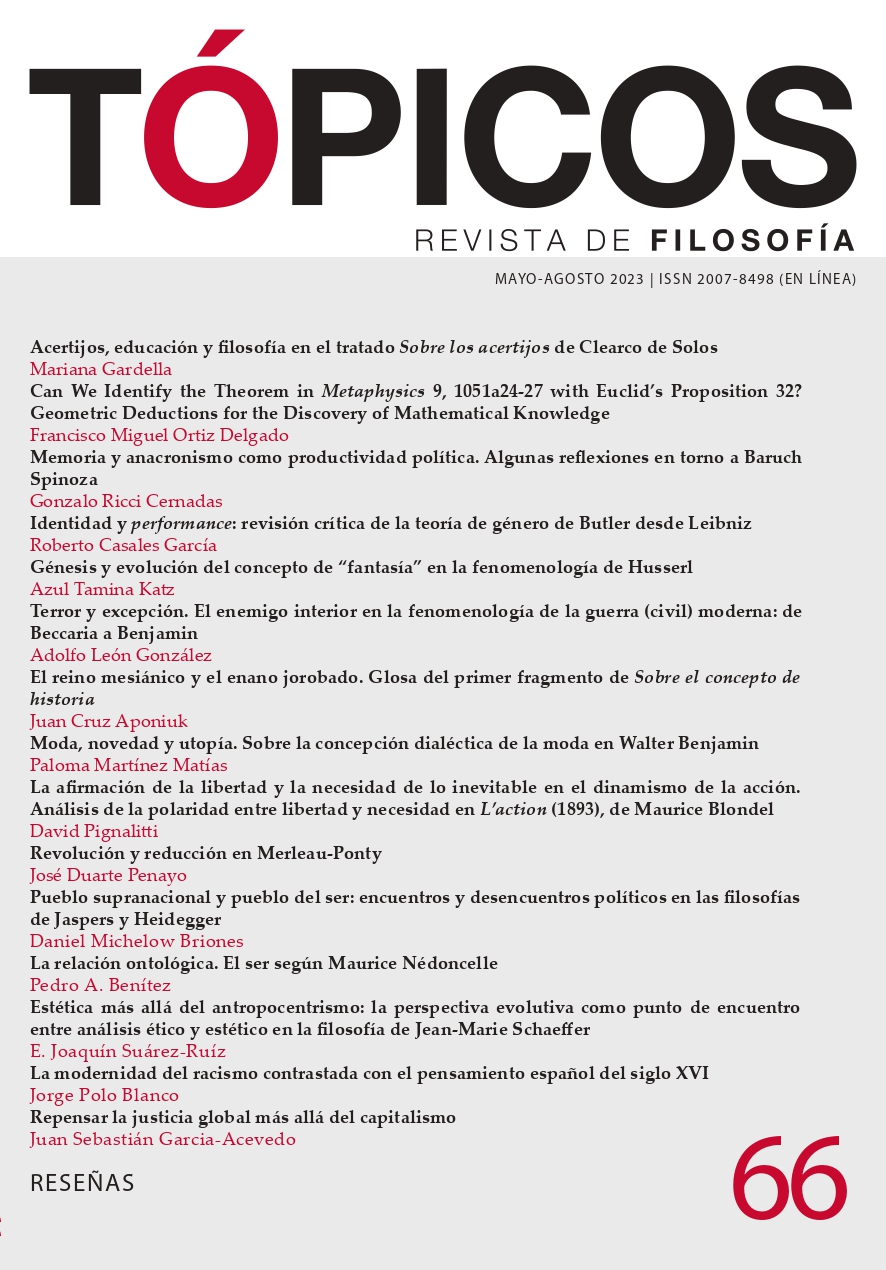¿Podemos identificar el teorema de Metafísica 9, 1051a24-27 con la proposición 32 de Euclides? Deducciones geométricas para el descubrimiento de conocimientos matemáticos
Publicado 2023-04-11
Palabras clave
- Aristóteles,
- geometría antigua,
- conocimiento matemático,
- metodología deductiva,
- teoremas
- acto,
- potencia ...Más
Derechos de autor 2023 Tópicos, Revista de Filosofía

Esta obra está bajo una licencia internacional Creative Commons Atribución-NoComercial-SinDerivadas 4.0.
Cómo citar
Resumen
El presente artículo posee dos objetivos concretos. Primero, demostrar que el teorema que se encuentra en Metafísica Θ 9, 1051a24-27, no es equivalente a la Proposición 32 de Euclides (contradiciendo a algunos comentaristas de Aristóteles, como W. D. Ross, J. L. Heiberg y T. L. Heith). Coincidiendo con el análisis de Henry Mendell, defiendo que los dos teoremas no son equivalentes; sin embargo, ofrezco diferentes razones para dicha divergencia: propongo una razón pedagógicofilosófica para que el teorema aristotélico sea más corto que el de Euclides (y que versiones previas del propio Aristóteles). El Estagirita desea enfatizar al procedimiento deductivo como un método satisfactorio para descubrir conocimientos científicos. El segundo objetivo, que se opone a un cierto consenso existente sobre las deducciones geométricas en Aristóteles, es proponer brevemente que el teorema, tal y como lo encontramos en la Metafísica y sin necesidad de ninguna enmienda al texto (oponiéndome a las enmiendas sugeridas por Henry Mendell), permite a Aristóteles demostrar que el conocimiento matemático universal está en potencia en las figuras geométricas. Esta propuesta tentativamente prueba que Aristóteles enfatiza que la deducción geométrica es suficiente para actualizar al conocimiento matemático.
Referencias
- Agashe, S. D. (1989). The Axiomatic Method: Its Origin and Purpose. Journal of Indian Council of Philosophical Research, 6(3), 109-118.
- Aristotle. (1924). Metaphysics. W. D. Ross (ed.). Clarendon Press. URL: http://www.perseus.tufts.edu/hopper/text?doc=Perseus%3Atext%3A1999.01.0051%3Abook%3D9%3Asection%3D1051a.
- Aristotle. ([1933] 1989a). Aristotle in 23 Volumes. Volume 17. H. Tredennick (trans.). Harvard University Press-William Heinemann Ltd. URL: http://www.perseus.tufts.edu/hopper/text?doc=Perseus%3Atext%3A1999.01.0052%3Abook%3D13%3Asection%3D1077b.
- Aristotle. ([1933] 1989b). Aristotle in 23 Volumes. Volume 18. H. Tredennick (trans.). Harvard University Press-William Heinemann Ltd. URL: http://www.perseus.tufts.edu/hopper/text?doc=Perseus%3Atext%3A1999.01.0052%3Abook%3D13%3Asection%3D1077b.
- Aristotle. (2006). Metaphysics, Book . L. Judson (ed). S. Makin (trans.). Clarendon Press-Oxford University Press.
- Barnes, J. (1981). Proof and the Syllogism. In E. Berti (ed.), Aristotle on Science: The “Posterior Analytics”. (pp. 17-59). Editrice Antenore.
- Bunge, M. (2001). Prólogo. Euclides dos mil años después. In L. Beppo, Leyendo a Euclides. (pp. 9-14). Libros del Zorzal.
- Burnyeat, M. F. (1984). Notes on Books Eta and Theta of Aristotle´s Metaphysics. J. Richardson Publishers-Oxford University Press.
- Bechler, Z. (1995). Aristotle´s Theory of Actuality. State University of New York.
- Cleary, J. C. (2010). Aristóteles. Acerca de los múltiples sentidos de prioridad. M. D. Boeri (trans.). Ediciones Colihue.
- Corcoran, J. (2009). Aristotle´s Demonstrative Logic. History and Philosophy of Logic, 30, 1-20.
- Corcoran, J. & Tracy, K. (2018). [Review of the paper “A Completed System for Robin Smith’s Incomplete Ecthetic Syllogistic”, by Pierre Joray ((2017). Notre Dame Journal of Formal Logic, 58(3), 329–342)]. Versión inédita, 1-7. URL: https://www.academia.edu/36231363/CORCORAN_TRACY_ON_ARISTOTLES_ECTHESIS.
- Corkum, P. (2012). Aristotle on Mathematical Truth. British Journal for the History of Philosophy, 20(6), 1057-1076.
- Euclide. (1883-1888). Euclidis Elementa. J. L. Heiberg (ed.). Teubner.
- Euclide. (1956). Euclid's Elements. T. Little Heath (trans). Dover. URL: http://www.perseus.tufts.edu/hopper/text?doc=Perseus%3atext%3a1999.01.0086
- Hintikka, J. (1966). Aristotelian Infinity. The Philosophical Review, 75(2), 197-218.
- Hoyrup, J. (2002). Existence, Substantiality, and Counterfactuality. Observations on the Status of Mathematics in Aristotle, Euclide, and Others. Centaurus, 44, 1-31.
- Lear, J. (1982). Aristotle on Mathematics. The Philosophical Review, 91, 161-192.
- Martí Sánchez, M. (2017). La filosofía de las matemáticas de Aristóteles. Tópicos, Revista de Filosofía, 52, 43-66. DOI: https://doi.org/10.21555/top.v0i52.784.
- Mendell, H. (1984). Two Geometrical Examples from Aristotle´s Metaphysics. The Classical Quarterly, 34(2), 359-372. URL: https://www.jstor.org/stable/638294.
- Mueller, I. (1970). Aristotle on Geometrical Objects. Archive für Geschichte der Philosophie, 52(2), 156-171.
- Mueller, I. (1974). Greek Mathematics and Greek Logic. In J. Corcoran (ed.), Ancient Logic and Its Modern Interpretations. (pp. 35-70). D. Reidel Publishing Company.
- Ross, W. D. (1924). Aristotle´s Metaphysics. Volume II. Oxford University Press.
- Hasper, P. S. & Yurdin, J. (2014). Between Perception and Scientific Knowledge: Aristotleʼs Account of Experience. Oxford Studies in Ancient Philosophy, 47, 119-150.
- Sorabji, R. (2003). Necesidad, causa y culpa. R. Salles (trans.). Universidad Nacional Autónoma de México.





